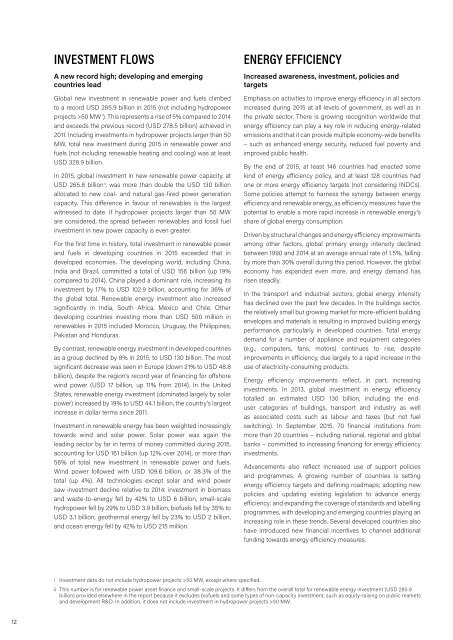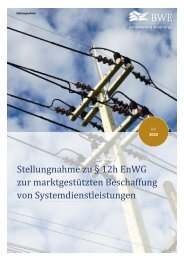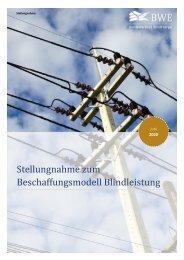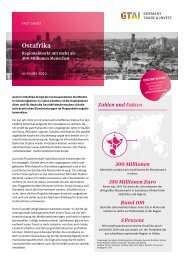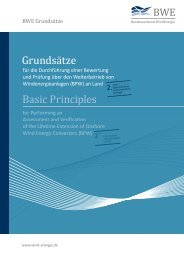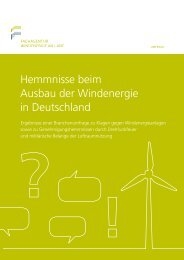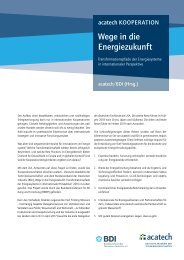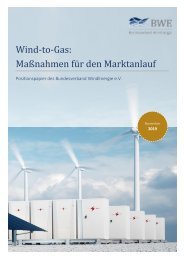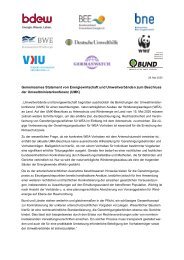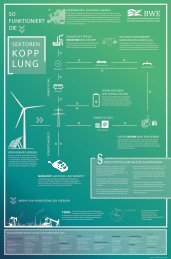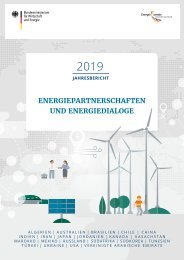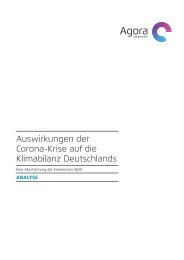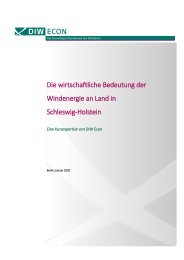Global Status Report 2016 - Key Findings
Der Renewables 2016 Global Status Report zeigt, dass erneuerbare Energien sich heute als wettbewerbsfähige und wichtige Energiequellen in vielen Ländern der Welt etabliert haben. 2015 war ein Rekordjahr für die Installation von erneuerbaren Energieanlagen. Der Zubau erneuerbarer Energiekapazität für die Stromproduktion verzeichnete mit 147 Gigawatt (GW) den größten Anstieg seiner Geschichte. Auch die Nutzung moderner Erneuerbarer für Wärmeerzeugung und im Verkehrssektor nahm zu. Dezentrale erneuerbare Energien verbreiten sich rapide und helfen somit die Lücke zwischen den„ Energiereichen“ und „Energiearmen“ zu schließen...... Herausgeber: Renewable Energy Policy Network for the 21. Century (REN21), Juni 2016
Der Renewables 2016 Global Status Report zeigt, dass erneuerbare Energien sich heute als wettbewerbsfähige und wichtige Energiequellen in vielen Ländern der Welt
etabliert haben.
2015 war ein Rekordjahr für die Installation von erneuerbaren Energieanlagen. Der Zubau erneuerbarer Energiekapazität für die Stromproduktion verzeichnete mit 147 Gigawatt (GW) den größten Anstieg seiner Geschichte.
Auch die Nutzung moderner Erneuerbarer für Wärmeerzeugung und im Verkehrssektor nahm zu. Dezentrale erneuerbare Energien verbreiten sich rapide und helfen somit die Lücke zwischen den„ Energiereichen“ und „Energiearmen“ zu schließen......
Herausgeber: Renewable Energy Policy Network for the 21. Century (REN21), Juni 2016
You also want an ePaper? Increase the reach of your titles
YUMPU automatically turns print PDFs into web optimized ePapers that Google loves.
INVESTMENT FLOWS<br />
A new record high; developing and emerging<br />
countries lead<br />
<strong>Global</strong> new investment in renewable power and fuels climbed<br />
to a record USD 285.9 billion in 2015 (not including hydropower<br />
projects >50 MW i ). This represents a rise of 5% compared to 2014<br />
and exceeds the previous record (USD 278.5 billion) achieved in<br />
2011. Including investments in hydropower projects larger than 50<br />
MW, total new investment during 2015 in renewable power and<br />
fuels (not including renewable heating and cooling) was at least<br />
USD 328.9 billion.<br />
In 2015, global investment in new renewable power capacity, at<br />
USD 265.8 billion ii , was more than double the USD 130 billion<br />
allocated to new coal- and natural gas-fired power generation<br />
capacity. This difference in favour of renewables is the largest<br />
witnessed to date. If hydropower projects larger than 50 MW<br />
are considered, the spread between renewables and fossil fuel<br />
investment in new power capacity is even greater.<br />
For the first time in history, total investment in renewable power<br />
and fuels in developing countries in 2015 exceeded that in<br />
developed economies. The developing world, including China,<br />
India and Brazil, committed a total of USD 156 billion (up 19%<br />
compared to 2014). China played a dominant role, increasing its<br />
investment by 17% to USD 102.9 billion, accounting for 36% of<br />
the global total. Renewable energy investment also increased<br />
significantly in India, South Africa, Mexico and Chile. Other<br />
developing countries investing more than USD 500 million in<br />
renewables in 2015 included Morocco, Uruguay, the Philippines,<br />
Pakistan and Honduras.<br />
By contrast, renewable energy investment in developed countries<br />
as a group declined by 8% in 2015, to USD 130 billion. The most<br />
significant decrease was seen in Europe (down 21% to USD 48.8<br />
billion), despite the region’s record year of financing for offshore<br />
wind power (USD 17 billion, up 11% from 2014). In the United<br />
States, renewable energy investment (dominated largely by solar<br />
power) increased by 19% to USD 44.1 billion, the country’s largest<br />
increase in dollar terms since 2011.<br />
Investment in renewable energy has been weighted increasingly<br />
towards wind and solar power. Solar power was again the<br />
leading sector by far in terms of money committed during 2015,<br />
accounting for USD 161 billion (up 12% over 2014), or more than<br />
56% of total new investment in renewable power and fuels.<br />
Wind power followed with USD 109.6 billion, or 38.3% of the<br />
total (up 4%). All technologies except solar and wind power<br />
saw investment decline relative to 2014: investment in biomass<br />
and waste-to-energy fell by 42% to USD 6 billion, small-scale<br />
hydropower fell by 29% to USD 3.9 billion, biofuels fell by 35% to<br />
USD 3.1 billion, geothermal energy fell by 23% to USD 2 billion,<br />
and ocean energy fell by 42% to USD 215 million.<br />
ENERGY EFFICIENCY<br />
Increased awareness, investment, policies and<br />
targets<br />
Emphasis on activities to improve energy efficiency in all sectors<br />
increased during 2015 at all levels of government, as well as in<br />
the private sector. There is growing recognition worldwide that<br />
energy efficiency can play a key role in reducing energy-related<br />
emissions and that it can provide multiple economy-wide benefits<br />
– such as enhanced energy security, reduced fuel poverty and<br />
improved public health.<br />
By the end of 2015, at least 146 countries had enacted some<br />
kind of energy efficiency policy, and at least 128 countries had<br />
one or more energy efficiency targets (not considering INDCs).<br />
Some policies attempt to harness the synergy between energy<br />
efficiency and renewable energy, as efficiency measures have the<br />
potential to enable a more rapid increase in renewable energy's<br />
share of global energy consumption.<br />
Driven by structural changes and energy efficiency improvements<br />
among other factors, global primary energy intensity declined<br />
between 1990 and 2014 at an average annual rate of 1.5%, falling<br />
by more than 30% overall during this period. However, the global<br />
economy has expanded even more, and energy demand has<br />
risen steadily.<br />
In the transport and industrial sectors, global energy intensity<br />
has declined over the past few decades. In the buildings sector,<br />
the relatively small but growing market for more-efficient building<br />
envelopes and materials is resulting in improved building energy<br />
performance, particularly in developed countries. Total energy<br />
demand for a number of appliance and equipment categories<br />
(e.g., computers, fans, motors) continues to rise, despite<br />
improvements in efficiency, due largely to a rapid increase in the<br />
use of electricity-consuming products.<br />
Energy efficiency improvements reflect, in part, increasing<br />
investments. In 2013, global investment in energy efficiency<br />
totalled an estimated USD 130 billion, including the enduser<br />
categories of buildings, transport and industry as well<br />
as associated costs such as labour and taxes (but not fuel<br />
switching). In September 2015, 70 financial institutions from<br />
more than 20 countries – including national, regional and global<br />
banks – committed to increasing financing for energy efficiency<br />
investments.<br />
Advancements also reflect increased use of support policies<br />
and programmes. A growing number of countries is setting<br />
energy efficiency targets and defining roadmaps; adopting new<br />
policies and updating existing legislation to advance energy<br />
efficiency; and expanding the coverage of standards and labelling<br />
programmes, with developing and emerging countries playing an<br />
increasing role in these trends. Several developed countries also<br />
have introduced new financial incentives to channel additional<br />
funding towards energy efficiency measures.<br />
i Investment data do not include hydropower projects >50 MW, except where specified.<br />
ii This number is for renewable power asset finance and small-scale projects. It differs from the overall total for renewable energy investment (USD 285.9<br />
billion) provided elsewhere in the report because it excludes biofuels and some types of non-capacity investment, such as equity-raising on public markets<br />
and development R&D. In addition, it does not include investment in hydropower projects >50 MW.<br />
12


